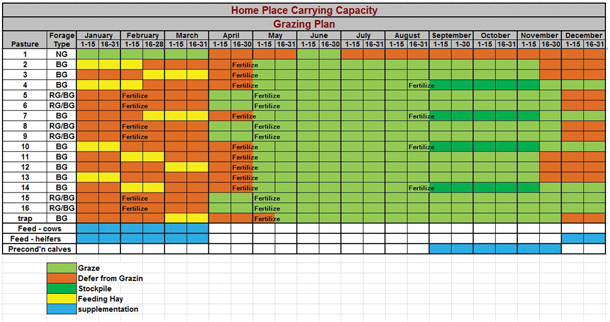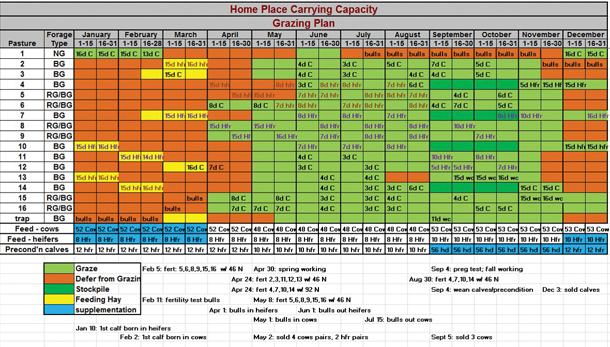A strategic plan is a high-level plan to achieve one or more goals under conditions of uncertainty, usually with limited resources.
Strategic planning is an entity’s process of defining its direction and making decisions on how to allocate its resources to pursue the strategy over a long period of time. Strategic grazing plans apply strategic planning to grazing management.
There is a purpose and process to developing a grazing plan. The purpose of a grazing plan is to think through the possible scenarios and outcomes given a specific set of resources and environment, address identified issues and develop a plan of action items for the greatest probability for success.
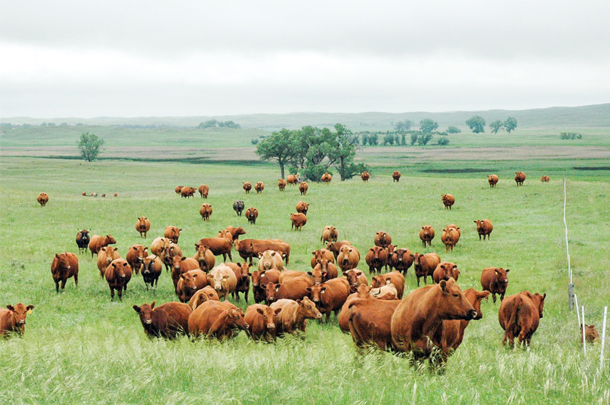 Cow herd preparing to rotate to the next grazing pasture.
Cow herd preparing to rotate to the next grazing pasture.
A strategic grazing plan is a dynamic template a grazier should refer to and adjust continually to adapt to the actual and anticipated near-future conditions. The plan is developed for ideal or average conditions and continually adjusted to address actual events.
The grazier actively anticipates coming events and alters the plan to reflect expectations on a routine basis (multiple times a week) and records actual activities and events as they occur.
Your strategic approach
Developing a strategic grazing plan includes several steps. The process begins with a predetermined goal or set of objectives with desired outcomes.
It includes developing an accurate inventory and assessment of resources, a projection of seasonal forage production and use, a list of annual management activities and dates they should occur, a list of specific issues to be addressed during the planning horizon and a list of meaningful measures and metrics to monitor progress toward goals.
The second step is projecting anticipated grazing events by pasture for the planning horizon (usually a year or less). The plan indicates dates for annual management activities such as breeding season, first processing or branding and weaning as well as other pertinent activities such as pasture monitoring dates, pasture deferments, crop establishment, fertilizer applications, bull sales to attend and family vacations.
The projected grazing plan is a type of map to assist in managing the operation while maintaining focus on key issues. As the future nears, the plan is adjusted to strategically meet the short-term application.
Click here or on the image above to view it at full size in a new window (PDF, 2.4MB)
The end result desired is often a calendared spreadsheet that lists pastures and records grazing events by management unit (with quantities, estimated average weights, etc.), management activities (dates of branding, weaning, breeding season, etc.) and other information such as rainfall, implementation of drought plan and unique events.
The best strategic grazing plans are rolling 12-month plans in which significant updates or planning sessions occur at least quarterly, preferably monthly.
From the information recorded, a grazier can develop meaningful metrics on production by pasture, forage type, soil type, level of fertilization, management area, etc. These metrics are used to determine if expectations were met and the progress made toward the identified objectives and goals.
Spreadsheets and calendars
For producers doing their first strategic grazing plan, the question is how to get started. There are several grazing plan worksheets available; it is often easier to purchase the worksheets than it is to design one.
Click here or on the image above to view it at full size in a new window (PDF, 2.4MB)
For a do-it-yourself template, one can start with an Excel spreadsheet and adapt it to one’s own property.
The design of a grazing worksheet typically lists the pastures by name down the first column, acres in the second column (grazable acres, if needed) and forage type to be managed and relative production value (score) in adjacent columns.
The next set of columns is the calendar. In the first draft, it is often useful to list the months of the year in the planning horizon to capture the basic management activities and grazing use by class of livestock to observe the plan from a broad view. Once the broad view is captured, it can be expanded into a weekly or daily format. It is from this format the actual events are recorded.
Once the template or spreadsheet is created, add the major management activities to be scheduled throughout the year. Mark the dates of routine and critical activities for the operation such as breeding dates, branding, weaning, marketing dates, planting and fertilizer/herbicide application schedules, forage assessment dates, family vacations and holidays.
The next set of information is the grazing scheme and the use of forage resources by season with the different groups or herds of livestock. This works best when developed with the property map in full view.
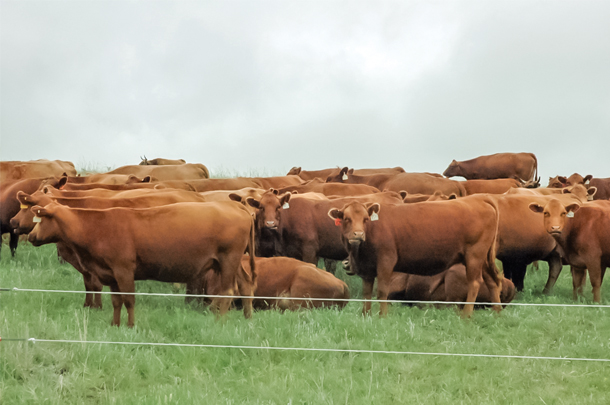 Cow herd resting behind an electric fence.
Cow herd resting behind an electric fence.
A grazier needs to note the special considerations that could impact grazing during the year, such as pastures with an intermittent water supply, pastures to be deferred for stockpiling forage, as calving areas or for prescribed burning and pastures to receive extended recovery after heavy impact.
Next, indicate on the plan the desired grazing schedule under normal conditions for the year ahead. Typically, the mature dry cattle are allocated the lowest-quality forages in any season, such as warm-season perennial grasses and crop residues, while the growing and lactating cattle are allocated the higher-quality forages, such as actively growing cool-season annual forages.
If multi-species grazing is employed, additional consideration should be given to the other livestock species relative to management needs and forage preferences. Optimum grazing and recovery periods relative to seasonal moisture conditions need to be calculated and factored into the grazing sequence within the plan.
Analyzing events
Once the long-term grazing template is in place, the grazier needs to analyze the short-term grazing events, management activities and weather conditions and make alterations to the plan, if needed, based on anticipated conditions. Then, record actual activities and events as they occur along with general observations that could be reflected upon in the future.
To make the grazing plan strategic, the grazier should be referring to it frequently throughout each week as management decisions and livestock rotations are made, always looking forward and adapting the plan based on anticipated conditions.
The part of developing a strategic grazing plan most often ignored is the measuring and monitoring to determine if progress is being made toward the desired goals and objectives. Implementing a routine monitoring component into the grazing plan assists in measuring progress.
Early diagnosis of lack of progress allows for early and timely implementation of an alternate management strategy.
The key to monitoring is keeping it simple and routine. Grazing exclosures, photo points and grazing records are some of the simpler and most useful monitoring tools. Other techniques such as transects and range/pasture health monitoring tools can be employed as well.
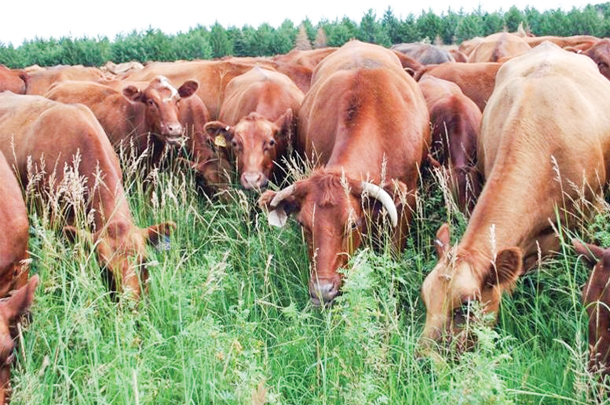 Close-up view of cows under high-stock-density grazing. Photos courtesy of the Noble Foundation.
Close-up view of cows under high-stock-density grazing. Photos courtesy of the Noble Foundation.
Forage assessments on critical dates across the seasons are extremely useful to monitor the balance between forage production and livestock demand.
By monitoring over time, a grazier can determine the amount or rate of progress being made through the use of a strategy. Monitoring can also indicate the need for a new strategy to be implemented and the extent to which adjustments are needed. A good example is the early recognition of conditions that warrant the implementation of a drought plan.
It has been said the initial grazing plan itself is of little value, as it will change considerably from the first draft, but it is the thought process of creating a strategic grazing plan that is important. Having experienced the process of developing a strategic grazing plan, a grazier is better prepared to make adjustments in strategy.
It is unlikely that the grazing plan will remain consistent through the planning horizon. Adjustments to the grazing plan will be made to adapt to the seasons and unforeseen situations. Weather patterns will certainly dictate.
However, the purpose of a strategic grazing plan is to allow the grazier to make better and timelier – strategic – grazing management decisions.

